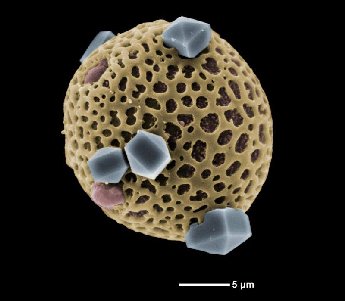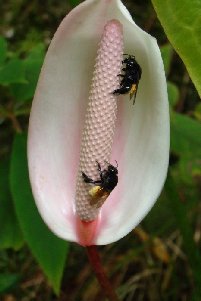Postdoctoral Researcher, University of Missouri – St. Louis, and Research Associate, Missouri Botanical Garden
Research interests
• Burmeistera (Campanulaceae) pollination syndromes
• Anthurium (Araceae) systematics, ecology and evolution
• Molecular phylogenetics, spatial distribution modeling and biogeography
• Species diversification in tropical regions and rapid radiations
• Plant-animal interactions
Background: Monica Carlsen is one of the specialists in the Araceae family at MOBOT, a diverse tropical plant family with ca. 3,000 species, highly valuable as ornamental plants and flowers. Her research focuses in understanding the rapid radiation of the species-rich (ca. 900 species) Neotropical genus Anthurium (“flamingo” or “wax flower”), integrating revisionary taxonomical studies, molecular phylogenetics, fossil calibrations and dating, biogeography and species distribution modeling. More recently, she became interested in the study of pollination syndromes (pollen analysis, floral fragrances, floral diversity) and their correlates with species diversification in the genus Burmeistera (Campanulaceae), a primarily bat-pollinated Neotropical group.
Web Page: MBG
Nathan Muchhala
Assistant Professor, University of Missouri – St. Louis
Background: Nathan Muchhala studies the role of interactions between species, especially mutualism and competition, in shaping communities and driving diversification. He is particularly interested in the evolution of pollination by bats and birds in the Neotropics, and questions such as: What traits adapt flowers to pollination by these animals? Conversely, how have bats and birds evolved to better exploit their floral resources? And how does this interaction affect the formation of new species? One current focus of his research involves understanding how pollinators and other factors have affected speciation in the genus Burmeistera (Campanulaceae), a species-rich clade of hemi-epiphytes with high endemism and high levels of co-occurrence (up to 6 species per site) distributed in cloud forests of Central and South America.
Web Page: The Muchhala Lab
Project 1: Fruit types, seed characters and dispersal ability in the genus Burmeistera (Campanulaceae). Species of the genus Burmeistera have one of two types of berries: either brightly-colored, fleshy cylinders, or dull-green, inflated ‘balloons’ with the seeds held in a ball in the center. The former type appears classically adapted to bird dispersal, and birds have been observed carrying off the fruits, while unusual latter type are something of a mystery in terms of their dispersal mode: they are never carried off, but instead fall to the ground under plants, and perhaps then are secondarily dispersed by ants or rodents. The purpose of this project will be to test the prediction that dispersal by flying animals leads to larger species distribution ranges than the mystery dispersal mode of the species with inflated berries. With the mentors’ guidance, the student will begin by working with the (dried) specimens in the herbarium collections to identify fruit type for each species and to study seeds using scanning electron microscopy for characters associated with the two dispersal modes. They will then compile locality information for these collections in order to georeference them using Google Maps and online gazetteers and produce species distribution models (SDMs) based on verified localities and climatic variables using ArcGIS, MaxEnt and other spatial analysis tools in R environment. Finally, the student will work with the mentors to statistically analyze species distributions in order to test the prediction that fruit type affects range size, and will help to prepare a publication of the results.
Project 2: Pollen characters and pollination syndromes as correlates of species diversification in the genus Anthurium (Araceae). Previous research within the genus Anthurium (Araceae) has suggested that switches in pollination syndromes have lead to an increase in species diversity in several groups, especially in bee-pollinated clades. The main objective of this project is to perform a detailed study of floral and pollen characters in several Anthurium species in order to understand the evolutionary history of these traits and their correlation with episodes of increased species diversification in certain geographical areas or clades. With the mentor’s guidance, the student will be involved in using herbarium (dried) and living Anthurium specimens to collect pollen samples and study floral characters, will learn to prepare pollen samples for observation under the scanning electron microscope (SEM), will collect, store and prepare floral samples for observation under dissecting scopes, will learn to describe basic floral and pollen morphological characters, and will comparatively analyze these characters and their influence in species diversification using a phylogenetic framework. The student will also help in the preparation of results for publication.
Selected Publications
- Carlsen, M. and Croat, T.B. 2013. A molecular phylogeny of the species-rich Neotropical genus Anthurium (Araceae) based on combined chloroplast and nuclear DNA. Systematic Botany 38(3): 576-588.
- Carlsen, M. 2011. Understanding the origin and rapid diversification of the genus Anthurium Schott (Araceae), integrating molecular phylogenetics, morphology and fossils. Ph.D. Dissertation, Department of Biology, University of Missouri – St. Louis, USA.
- Chouteau, M., Gibernau, M. and Barabe, D. 2008. Relationships between floral characters, pollination mechanisms, life forms, and habitats in Araceae. Botanical Journal of the Linnean Society 156: 29–42.
- Franz, N. 2007. Pollination of Anthurium (Araceae) by derelomine flower weevils (Coleoptera: Curculionidae). Rev. Biol. Trop. 55 (1): 269-277.
- Gibernau, M. 2003. Pollinators and visitors of aroid inflorescences. Aroideana 26: 66-83.
- Buss, C.C., Lammers, T.G. and Wise, R.R. 2001. Seed coat morphology and its systematic implications in Cyanea and other genera of Lobelioideae (Campanulaceae). American Journal of Botany 88(7): 1301-1308.
 |
 |